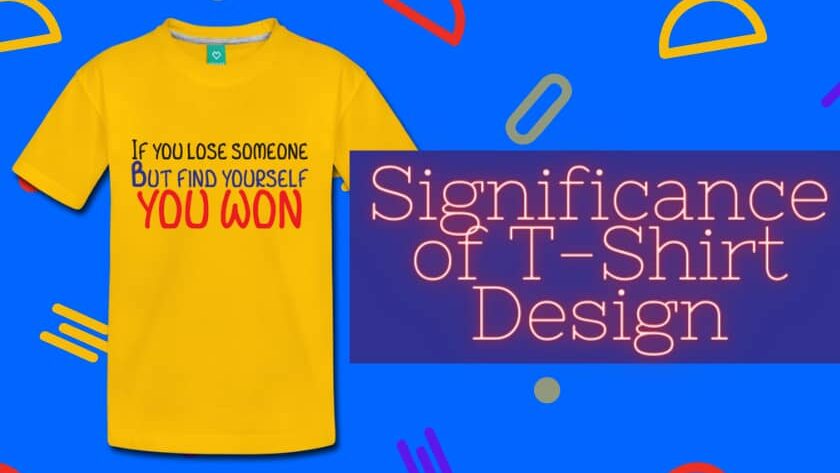T-shirts are a popular type of clothing in today’s world. You’ve probably noticed that everyone and everything is wearing T-shirts if you’ve been walking down the street recently. Why is it referred to as a T-shirt or a Tee shirt? It is also spelled “Tee.” According to online Cambridge dictionaries, a simple piece of clothing covers the top half of the body, has no collar, and usually has short sleeves. It lacks a pocket button and, in general, a collar. A T-shaped piece of fabric is used to make the body and sleeves. Cotton is the primary raw material, and jerseys are occasionally utilized in sportswear (cloth).
Originally made of wool, it is now wool, cotton, and synthetic fibers. So it just clothes? T-shirts are cheap and helpful in keeping our bodies covered. According to Walters and Fletcher (2001), a T-shirt can be a portable advertisement, with the wearer publicly declaring their political, musical, or social affiliations. As a walking billboard or a medium for people to express themselves. T-shirts invariably elicit a reaction, with shocking, controversial, or humorous graphics that either offend or amuse depending on your age, gender, political beliefs, or mood on that particular day. As a result, we know that T-shirts can be a valuable tool for spreading an identity simply by printing a graphic on a T-shirt and having people wear it to send out the message.
Graphics or slogans printed on T-shirts have also contributed to the brand’s iconic status. Matt says message T-shirts are the most popular personalized T-shirts (2012). To others, a t-shirt can reveal a lot about your identity. If it contains personal information about you or something else, do not open it; however, read it if it is of interest to you. T-shirts, for example, combine simple slogans and printed graphics to convey a message; they can be as simple as possible when people see the T-shirt for the first time and understand what it means. They are comfortable, versatile, and fashionable in the twenty-first century. Anyone can advertise their personality or brand on the street by simply wearing a T-shirt as a walking billboard to express a message to each other.
According to Thomson (2011), printed T-shirts are becoming increasingly popular as a valuable advertising vehicle and a powerful medium for expressing a person’s emotion or fashion statement. There is an effective way to promote a brand’s identity on its own, and it is also the most cost-effective medium. As a result, T-shirt designers play an essential role in the advertising industry because they are the ones who experiment with visuals and broaden the market beyond T-shirts to include advertising purposes. According to Bou, T-shirts are used as a protest symbol, an advertisement, a political campaign sign, and a mean for many artists and designers to express themselves and promote their work.
Let us all work together to liberate the Earth from its current shackles. Our planet requires our help! If you’re looking for your favorite musician’s most recent graphic design t-shirt, look no further. Then check out Rockabilia. Rockabilia offers high-quality printed shirts, footwear, sweatshirts, bottoms, accessories, and many other items from your favorite movies and bands. Don’t forget to use the Rockabilia Discount Code to get 30% off.
T-shirts gained popularity over time, and they became an effective advertising tool. As a result, T-shirts are effective because they travel as far as the wearer. On clothing, many different types of design applications are now used. Examples include screen printers, silk screeners, embroiderers, plotters, and air brushers.
This dissertation’s primary goal is to identify and analyze how modern customize. T-shirts are an effective medium in advertising, specifically how they work on awareness campaigns, corporate, commercial, and event advertising. We will look at these topics in the following chapters the history of the T-shirt. Aside from that, the design or imagery used in various eras that resulted in T-shirt advertising will be discussed. A few related case studies will be presented as supporting material in the analysis.
The origins of the T-shirt
T-shirts have evolved from underwear, outerwear, military uniforms, and sportswear throughout history. T-shirts first appeared in the early 1880s, according to Easby and Oliver (2007), with some claiming that it was a plain white cotton shirt worn as an undergarment as part of the US navy uniform. T-shirts spread to the heat of the Pacific, as they had in World War II, and became the dominant uniform of US soldiers. However, they quickly realized that wearing white T-shirts made them an easy target, so they brought in sage-green T-shirts late in the war. On the other hand, T-shirts were not acceptable to wear on their own until 1942, when they even had something written on them. Using screen printing and stenciling techniques, soldiers began creating a message board as a piece of clothing.
They make T-shirts with their station, corps, or point of view printed on them. On July 13, 1942, an “Air Corps Gunnery School” T-shirt with the message “Air Corps Gunnery School” appeared alongside a muscular soldier on the cover of LIFE magazine. This cover was the first to bring the worn T-shirt trend to the public’s attention. Following the massive T-shirt trend of the 1950s, movie star Marlon Brando wore one in “A Streetcar Named Desire,” which became fashionable outerwear garments. Budweiser, the beer manufacturer, was one of the first major brands to use T-shirts as a marketing promotion tool in 1965, according to Walters and Fletcher (2001), and it began stamping its logo on shirts. According to Steele (2010), over the next decade, the concept spread to all types of brands, from Bic to Xerox.




